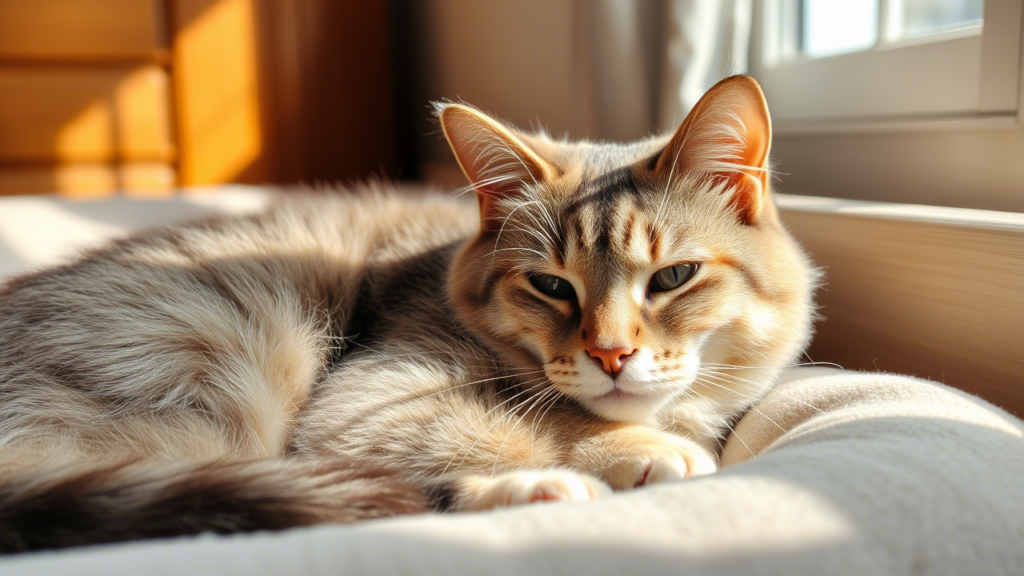10 Simple Ways To Comfort And Calm Down Your Anxious Cat
Cats, just like humans, can experience anxiety, and it can be distressing to see your feline friend struggle with fear and nervousness. Fortunately, there are plenty of ways to help your anxious cat feel more comfortable and at ease. Whether it’s creating a calm home environment, engaging in relaxing activities, or providing calming support, there are numerous strategies to ease your cat’s anxiety.

By understanding your cat’s unique needs and applying effective techniques, you can make a real difference in their overall well-being. Below are 10 expert-approved tips to help reduce anxiety in your cat, allowing them to feel more secure and relaxed.
1. Create a Peaceful Environment
One of the most effective ways to reduce your anxious cat’s stress is by ensuring their environment is calm and quiet. Cats are sensitive creatures, and loud noises or sudden disturbances can heighten their anxiety. To help your cat relax, use soft lighting and consider adding a calming water fountain to provide soothing background noise.
Additionally, make sure your cat has a cozy space where they can retreat when needed. A cat bed near a window, where they can observe the outside world, is an excellent choice. Elevated areas like cat trees or shelves can also make your cat feel safer, as they can observe their environment from above.
These environmental changes create a sanctuary for your anxious cat, helping to lower their stress levels and boost their overall happiness.
2. Engage in Interactive Playtime
Interactive play is an excellent way to channel your anxious cat’s energy and reduce stress. Use toys that mimic hunting behaviors, like feather wands or laser pointers, to engage your cat’s natural instincts. This not only provides mental and physical stimulation but also strengthens the bond between you and your cat.
Set aside at least 15 minutes daily for interactive play, ensuring you provide variety in toys to keep things exciting. Regular play helps your cat release pent-up energy and promotes relaxation, which can significantly reduce anxiety over time.
3. Provide Safe Spaces
An anxious cat needs access to safe, quiet spaces where they can feel secure and retreat from potential stressors. Consider setting up small, enclosed areas, such as cat tents or boxes lined with soft blankets, that offer your cat a sense of security.
In addition to physical hideaways, you can use pheromone diffusers in these spaces. These products emit calming scents that mimic natural feline pheromones, promoting relaxation and tranquility. With these safe spaces, your cat has a retreat when they feel overwhelmed, allowing them to self-soothe and manage their anxiety.
4. Incorporate Regular Grooming Sessions
Grooming sessions can be a calming ritual for an anxious cat. Brushing your cat gently mimics the feeling of being groomed by their mother, providing comfort and relaxation. Use a soft brush that suits your cat’s fur type and pay attention to their body language to ensure they enjoy the experience.
Regular grooming not only helps reduce anxiety but also promotes good health by removing loose fur and preventing matting. Plus, grooming sessions provide an opportunity to check for any health issues, such as skin irritations or parasites.

5. Use Calming Music
Playing calming music can have a soothing effect on an anxious cat. Music composed specifically for cats—featuring classical tunes or nature sounds—can help relax your cat and mask stressful background noises.
Create a calming atmosphere by playing this music in a quiet area of your home. Over time, you may notice that your cat begins to associate the sound of soothing music with relaxation, helping them feel more at ease. Be sure to observe your cat’s reactions, as some cats prefer different types of calming sounds, such as rainfall or ocean waves.
6. Establish a Consistent Routine
Cats thrive on routine, and a predictable schedule can help alleviate anxiety. An anxious cat benefits from having set times for feeding, play, and rest. A consistent daily routine offers comfort and reassurance, as your cat will know what to expect.
Be mindful of sudden changes, as they can trigger stress and disrupt your cat’s sense of security. If changes are unavoidable, introduce them gradually to avoid overwhelming your cat. By maintaining a routine, you provide a stable and calming environment for your anxious cat.
7. Introduce Comforting Scents
Certain scents, like lavender or chamomile, are known for their calming properties and can help ease your anxious cat. You can use a pet-safe diffuser in areas where your cat spends time to release soothing aromas.
Be sure to choose only cat-safe essential oils, as some can be harmful to felines. Alternatively, feline-specific calming sprays are available, providing a safe and effective way to introduce relaxing scents into your home. The addition of comforting scents can create a tranquil environment for your cat, helping them feel more at ease.

8. Use Therapeutic Touch
Physical touch can be incredibly calming for an anxious cat. Gentle petting or massage can help reduce stress and reinforce the bond between you and your feline companion. Focus on areas your cat enjoys being touched, such as under the chin or behind the ears, and use slow, deliberate movements.
Therapeutic touch can be especially beneficial if your cat has experienced past trauma or stress. Over time, regular sessions of calm, soothing touch can help your cat feel more secure and reduce anxiety.
9. Consider Dietary Supplements
Dietary supplements can support your cat’s overall health and well-being, and certain supplements are known for their calming effects. Omega-3 fatty acids, found in fish oil, can help reduce anxiety by supporting your cat’s nervous system.
Before introducing any new supplements, consult with your veterinarian to ensure they are appropriate for your cat’s specific needs. Calming chews, powders, or treats are convenient and easy to administer, helping your cat feel more relaxed.
10. Seek Professional Help if Needed
If your anxious cat’s behavior doesn’t improve with home remedies, seeking professional help may be necessary. Veterinarians or animal behaviorists can assess your cat’s anxiety and recommend tailored treatment options. In some cases, your cat may benefit from behavior modification techniques or medication.
A professional can help identify underlying issues causing anxiety and provide a treatment plan that ensures your cat receives the best care. Regular check-ups and consultations will allow you to address any health concerns and improve your cat’s overall well-being.
Conclusion
Helping your anxious cat requires patience, understanding, and a variety of techniques to alleviate their stress. From creating a peaceful environment and engaging in interactive play, to introducing calming scents and therapeutic touch, there are many ways to reduce anxiety in cats. By implementing these tips and maintaining a consistent, reassuring routine, you can help your feline friend feel more secure and comfortable in their environment.
FAQ Section: Helping an Anxious Cat
Q: How can I tell if my cat is anxious?
A: Signs of anxiety in cats include excessive hiding, restlessness, aggression, loss of appetite, or changes in litter box behavior. If you notice these signs, it’s essential to address your cat’s anxiety with calming techniques.
Q: Can anxiety in cats be treated naturally?
A: Yes, many natural remedies, such as pheromone diffusers, calming music, and safe scents, can help ease your cat’s anxiety. However, in some cases, professional help or medication may be needed for severe anxiety.
Q: Is it safe to use essential oils around my cat?
A: While some essential oils, like lavender and chamomile, are calming, not all oils are safe for cats. Always use pet-safe oils or choose products designed specifically for cats to avoid harmful effects.
Q: How long does it take to calm an anxious cat?
A: The time it takes to calm an anxious cat varies depending on the individual and the underlying cause of their anxiety. With consistent effort and the right techniques, many cats begin to show improvement within a few weeks.
